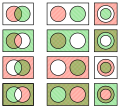File:Intersections of two sets and their complements.svg

Size of this PNG preview of this SVG file: 800 × 438 pixels. Other resolutions: 320 × 175 pixels | 640 × 350 pixels | 1,024 × 560 pixels | 1,280 × 700 pixels | 2,560 × 1,401 pixels | 1,800 × 985 pixels.
Original file (SVG file, nominally 1,800 × 985 pixels, file size: 78 KB)
File history
Click on a date/time to view the file as it appeared at that time.
| Date/Time | Thumbnail | Dimensions | User | Comment | |
|---|---|---|---|---|---|
| current | 11:23, 29 June 2020 |  | 1,800 × 985 (78 KB) | Watchduck | include another case, color borders |
| 23:52, 28 June 2020 |  | 1,444 × 988 (63 KB) | Watchduck | include another column | |
| 22:17, 28 June 2020 |  | 1,093 × 988 (46 KB) | Watchduck | {{Information |description =These (Venn and) Euler diagrams show, that the distinction between {{w|disjoint sets|}} and sets in a {{w|subset}} relation depends on how the sets are labelled. There is an actual difference between the column on the left and the two columns on the right. But the difference between the two columns on the right is only, whether the red set or its complement is considered ''the set''. |date = |source ={{own}} |author ={{Watchduck}} }} [[Cat... |
File usage
The following 2 pages use this file:
